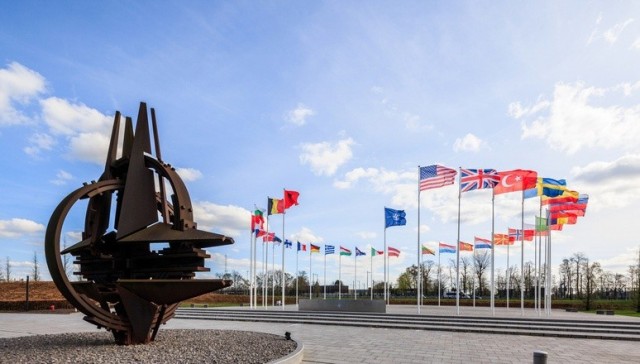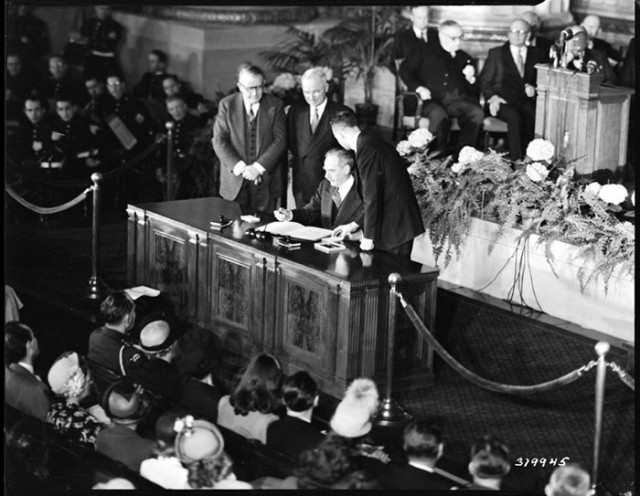U.S. Secretary of State Dean Acheson signs the Washington Treaty, also known as the North Atlantic Treaty, in Washington, D.C. on April 4, 1949. President Harry Truman and Vice President Alben Barkley are standing next to him.
VIEW ORIGINAL
Editor’s Note: The following story is a part of USAG Benelux’s “Honoring our Legacy” series in which we tell stories of World War I, World War II, the formation of the North Atlantic Treaty Organization (NATO) and alliance achievements throughout the decades.
CHIEVRES, Belgium — On April 4, 1949, less than four years after the end of World War II, 12 nations from Europe and North America signed the Washington Treaty and NATO was born.
This group of one dozen nations — Belgium, Canada, Denmark, France, Iceland, Italy, Luxembourg, the Netherlands, Norway, Portugal, the United Kingdom and the United States – understood the great strength of collective defense and the vast potential that defense cooperation could bring for peace and security of the Euro-Atlantic area.
In addition to being the founding document for NATO’s concept of collective defense, the Washington Treaty also includes specific articles that provide a framework for how it is realized by allied states. At the heart of the North Atlantic Treaty is the solidarity expressed in Article 5, which states that an attack against one ally is considered as an attack against all allies. This unequivocal pledge of mutual defense is one of the primary reasons NATO continues to be the largest peacetime alliance in the world, which has nearly tripled in size over the decades to 32 members.
“Just as the Army has transformed and adapted to multi-domain operations over the years, NATO has successfully adapted and transformed to meet the challenges of an increasingly dangerous; addressing the multiple risks and threats to alliance security require a 360-degree approach to defense,” said Col. Lindsay R. Matthews, commander of U.S. Army Garrison Benelux. “USAG Benelux provides critical support and services to the NATO community and it’s now more important than ever to continue defense cooperation. We are committed to supporting the preservation of peace by the Alliance for another 75 years.”

The “NATO Star” sculpture, dedicated in 1971, was the first artwork commissioned for NATO’s Headquarters in Belgium. Since then, the NATO star has become one of the most popular attractions for visitors, serving as the background for both official and non-official photos. The steel sculpture, inspired by the NATO star emblem, was designed by Belgian architect Raymond Huyberechts and features the star along with two circles symbolizing Europe and North America.
VIEW ORIGINAL
Decade after decade, NATO’s ability to adapt and transform enabled the Alliance to successfully manage a wide range of security challenges. From its original Cold War mission of countering the Soviet Union’s expansion in Europe to supporting the United States in the aftermath of the Sept. 11, 2001 terror attacks, which included the alliance’s first and only declaration of Article 5, NATO allies have stood firm in solidarity.
The current threat of Russia’s unprovoked war against Ukraine on the doorstep of the alliance serves as a reminder that peace in the Euro-Atlantic area cannot be taken for granted. Like a defense umbrella, NATO has shielded generations of allied citizens by preserving peace and security for alliance members while simultaneously growing and welcoming 20 additional nations into the NATO family.
Although the alliance has adapted and transformed over the past 75 years, one thing that hasn’t changed is NATO’s core purpose of self-defense. Despite the addition of new members since its founding, the collective defense security pledge of Article 5 remains a bedrock of the alliance. Additionally, the ideals upon which NATO was founded in 1949 remain the very same that the alliance is committed to today.
As described by the NATO Parliamentary Assembly’s Standing Committee, NATO’s success is directly connected to its founding core principles, “For 75 years, NATO has succeeded throughout all shifts in the security environment because it is defined not by what it stands against but by what it stands for — the defence of democracy, individual liberty and the rule of law.”
Over the past 75 years NATO has grown in both size and scope to become the protector of freedom for nearly one billion allied citizens. Through its primary tasks of deterrence and collective defense, NATO continues to serve as a unifying force that brings nations of the Euro-Atlantic area together for continued peace and security across the alliance for generations to come.
This article, Army Celebrates NATO's 75th Anniversary, was originally published by The Army .








